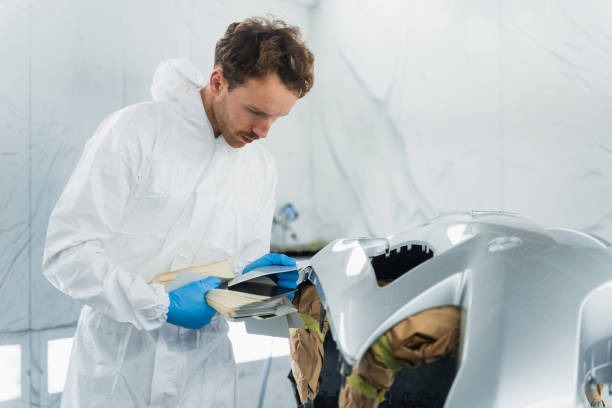Choosing the right paint is essential for long-lasting, professional results. This guide helps you select the best paint for walls, wood, metal, or masonry, ensuring your surfaces look great and stay protected while avoiding common mistakes.
Understanding Paint Basics
Paint isn’t just about color. It’s a blend of pigments, binders, solvents, and additives that all come together to protect and beautify surfaces. Two main types of paint cover most household and commercial projects:
- Water-based (latex or acrylic) paints: Quick to dry, low in odor, and easy to clean up with water. They’re an excellent choice for most walls and ceilings.
- Oil-based (alkyd) paints: Offer a durable, smooth finish and are particularly suited for trim, furniture, and areas that require additional resistance to wear. Cleanup requires mineral spirits or turpentine, and they take longer to dry.
Choosing between these two depends on the surface, environment, and the result you want.
Matching Paint to the Surface
Every surface comes with its own quirks and needs. Here’s how to tackle the most common ones:
Walls and Ceilings
Recommended Paint: Water-based (Latex or acrylic)
Interior walls and ceilings call for paints that are easy to apply, fast to dry, and simple to clean. Flat and matte finishes hide imperfections well and work nicely for ceilings and low-traffic areas, while eggshell, satin, or semi-gloss finishes are better suited for walls in kitchens, bathrooms, and hallways. These finishes offer a subtle sheen that stands up to occasional scrubbing.
Tip: Don’t forget to use a dedicated primer on bare drywall or when you’re drastically changing colors. Primers help paint adhere better and even out the original surface color.
Wood Surfaces
Recommended Paint: Water-based or oil-based, depending on use
Wood is versatile but demands the right prep and product. For interior woodwork (such as doors, trim, and furniture), oil-based paints deliver a smooth and resilient finish. They’re a classic choice for high-traffic and impact-prone areas. If you prefer quick drying and easier cleanup, high-quality latex paints work well for many indoor elements.
For exterior wood, consider exterior-grade latex paints with added flexibility to accommodate wood’s natural movement. These paints resist cracking, peeling, and mold, ensuring the wood stays protected in changing weather.
Tip: Always prime bare wood—even if the paint says it’s “paint and primer in one.” This step seals knots and prevents tannin bleed.
Metal Surfaces
Recommended Paint: Specialized metal paints (oil-based or latex, anti-rust formulas)
Metal surfaces require a paint that can handle temperature swings, moisture, and the threat of rust. Oil-based paints traditionally offer great adhesion and protection for metal, but modern water-based paints with anti-corrosive properties are robust choices as well.
For outdoor metals like railings, gates, and light fixtures, be sure to use paint labeled for exterior metal and incorporate anti-rust features. Alternatively, powder coating steel, like that offered in Utah, provides a durable, long-lasting finish that resists weathering. For indoor projects, a multi-surface latex with metal compatibility can provide a clean look without excessive fumes.
Preparation: Remove all traces of rust and old paint, then apply a metal primer to discourage further corrosion.
Masonry and Brick
Recommended Paint: Masonry paint (acrylic latex, elastomeric coatings)
Concrete, brick, and cement need more than just color. They need protection from moisture and weathering. Masonry paint is thicker and flexible, allowing it to fill small cracks and resist peeling. Acrylic latex is a reliable option for most applications, while elastomeric coatings add even more waterproofing for exterior surfaces exposed to the elements.
Preparation: Make sure the surface is dry and free of efflorescence or crumbling. Some masonry paints require a special primer or conditioner for best adhesion.
Tile and Glass
Recommended Paint: Epoxy, enamel, or specialty surface paint
These slick surfaces challenge traditional paints. For ceramic tile and glass, specialty epoxy or enamel paints adhere better and create a hard, washable finish. These are often used on tiles in low-traffic wall areas (like backsplashes) or to update old glass fixtures.
Preparation: Thorough cleaning and a light sanding or the application of a bonding primer are crucial for a lasting finish.
Finishes Explained
Beyond just picking the right “type” of paint, consider its finish.
- Flat/Matte: Non-reflective, hides surface flaws, best for ceilings and low-traffic areas.
- Eggshell: Subtle sheen, easy to clean, good for most walls.
- Satin: Soft gloss, durable and scrubbable, perfect for kitchens and baths.
- Semi-gloss/Gloss: High shine, resistant to moisture and wear, ideal for trim, doors, and cabinets.
Conclusion
Selecting the right paint for each surface is key to beautiful, durable results. Take the time to understand your materials and choose compatible paints and primers. The effort you invest up front will reward you with walls, woodwork, and outdoor features that look stunning and stay protected for years to come.

